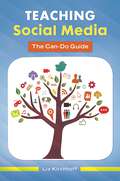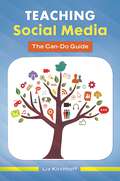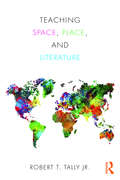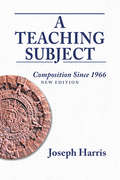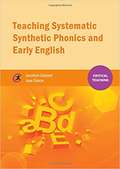- Table View
- List View
Teaching Shakespeare with Purpose: A Student-Centred Approach
by Ayanna Thompson Laura TurchiWhat does it mean to teach Shakespeare with purpose? It means freeing teachers from the notion that teaching Shakespeare means teaching everything, or teaching “Western Civilisation” and universal themes. Instead, this invigorating new book equips teachers to enable student-centred discovery of these complex texts. Because Shakespeare's plays are excellent vehicles for many topics -history, socio-cultural norms and mores, vocabulary, rhetoric, literary tropes and terminology, performance history, performance strategies - it is tempting to teach his plays as though they are good for teaching everything. This lens-free approach, however, often centres the classroom on the teacher as the expert and renders Shakespeare's plays as fixed, determined, and dead. Teaching Shakespeare with Purpose shows teachers how to approach Shakespeare's works as vehicles for collaborative exploration, to develop intentional frames for discovery, and to release the texts from over-determined interpretations. In other words, this book presents how to teach Shakespeare's plays as living, breathing, and evolving texts.
Teaching Shakespeare with Purpose: A Student-Centred Approach
by Ayanna Thompson Laura TurchiWhat does it mean to teach Shakespeare with purpose? It means freeing teachers from the notion that teaching Shakespeare means teaching everything, or teaching “Western Civilisation” and universal themes. Instead, this invigorating new book equips teachers to enable student-centred discovery of these complex texts. Because Shakespeare's plays are excellent vehicles for many topics -history, socio-cultural norms and mores, vocabulary, rhetoric, literary tropes and terminology, performance history, performance strategies - it is tempting to teach his plays as though they are good for teaching everything. This lens-free approach, however, often centres the classroom on the teacher as the expert and renders Shakespeare's plays as fixed, determined, and dead. Teaching Shakespeare with Purpose shows teachers how to approach Shakespeare's works as vehicles for collaborative exploration, to develop intentional frames for discovery, and to release the texts from over-determined interpretations. In other words, this book presents how to teach Shakespeare's plays as living, breathing, and evolving texts.
Teaching Social Justice Using Postcolonial Texts: Encountering Pedagogies of Discomfort in Practice (Sustainable Development Goals Series)
by Teresa Strong-Wilson Geraldine Balzer Anne BurkeThis book explores how teachers can re-examine their emotional investments in enacting dominant settler values through changing their text selection and teaching practices. Based on a longitudinal qualitative research study conducted by a national team of literacy scholars in collaboration with practicing literacy teachers at eight sites across Canada, the book investigates how groups of teachers, working collaboratively in inquiry groups, develop and implement curriculum to promote their own and their students’ understandings of social justice in postcolonial and settler spaces. In particular, the book highlights the rich and dynamic landscape of postcolonial authors, illustrators and texts, the development of culturally- sensitive curricula, and critical pedagogies possible in addressing contemporary and historical issues, both local and global. This book is primarily of interest to literacy scholars, literacy instructors (teacher educators) in teacher education programs, educational leaders, practicing teachers from the K-12 spectrum, and school district staff and policy makers with responsibilities for or interests in the potential of literacy and literature engagement for social justice education. The book is also be of interest to postsecondary educators and teacher educators wishing to use literature in social justice, anti-racist, and anti-oppressive courses.
Teaching Social Media: The Can-Do Guide
by Liz KirchhoffLibrarians who want to begin, expand, or improve their programs on teaching social media to adults and teens will find this guide invaluable.Sharing social media expertise with library clientele is a natural way for libraries to support their communities—and increase their relevance. This book provides a roadmap for librarians who wish to offer this service but need to brush up on their own social media skills or learn how to cover the topics in a classroom situation.Although there are many books on social media, this volume is unique because it presents complete teaching scripts that can be adapted for various classroom situations along with general guidelines and tips. You'll find general advice on social media as well as suggestions for getting support for the program, creating a syllabus tailored to community needs, and planning class format and logistics. Entire chapters cover Twitter, Facebook, LinkedIn, Foursquare, Pinterest, Yelp, and Google+, explaining how these sites work and how to use them to your advantage, as well as some of the privacy and safety concerns surrounding them and how they are trending. Class variations such as Twitter for Business and How to Plan Your Trip Online are also discussed, as are other classes to consider—for example, Tumblr and Instagram—and how to develop them.
Teaching Social Media: The Can-Do Guide
by Liz KirchhoffLibrarians who want to begin, expand, or improve their programs on teaching social media to adults and teens will find this guide invaluable.Sharing social media expertise with library clientele is a natural way for libraries to support their communities—and increase their relevance. This book provides a roadmap for librarians who wish to offer this service but need to brush up on their own social media skills or learn how to cover the topics in a classroom situation.Although there are many books on social media, this volume is unique because it presents complete teaching scripts that can be adapted for various classroom situations along with general guidelines and tips. You'll find general advice on social media as well as suggestions for getting support for the program, creating a syllabus tailored to community needs, and planning class format and logistics. Entire chapters cover Twitter, Facebook, LinkedIn, Foursquare, Pinterest, Yelp, and Google+, explaining how these sites work and how to use them to your advantage, as well as some of the privacy and safety concerns surrounding them and how they are trending. Class variations such as Twitter for Business and How to Plan Your Trip Online are also discussed, as are other classes to consider—for example, Tumblr and Instagram—and how to develop them.
Teaching Social Studies to English Language Learners
by Stephen J. Thornton Bárbara C. CruzTeaching Social Studies to English Language Learners provides readers with a comprehensive understanding of both the challenges that face English language learners (ELLs) and ways in which educators might address them in the social studies classroom. The authors offer context-specific strategies for the full range of the social studies curriculum, including geography, U.S. history, world history, economics, and government. These practical instructional strategies will effectively engage learners and can be incorporated as a regular part of instruction in any classroom. An annotated list of web and print resources completes the volume, making this a valuable reference to help social studies teachers meet the challenges of including all learners in effective instruction. Features and updates to this new edition include: • An updated and streamlined Part 1 provides an essential overview of ELL theory in a social studies specific-context. • "Teaching Tips" offer helpful suggestions and ideas for creating and modifying lesson plans to be inclusive of ELLs. • Additional practical examples and new pedagogical elements in Part 3 include more visuals, suggestions for harnessing new technologies, discussion questions, and reflection points. • New material that takes into account the demands of the Common Core State Standards, as well as updates to the web and print resources in Part 4.
Teaching Social Studies to English Language Learners
by Stephen J. Thornton Bárbara C. CruzTeaching Social Studies to English Language Learners provides readers with a comprehensive understanding of both the challenges that face English language learners (ELLs) and ways in which educators might address them in the social studies classroom. The authors offer context-specific strategies for the full range of the social studies curriculum, including geography, U.S. history, world history, economics, and government. These practical instructional strategies will effectively engage learners and can be incorporated as a regular part of instruction in any classroom. An annotated list of web and print resources completes the volume, making this a valuable reference to help social studies teachers meet the challenges of including all learners in effective instruction. Features and updates to this new edition include: • An updated and streamlined Part 1 provides an essential overview of ELL theory in a social studies specific-context. • "Teaching Tips" offer helpful suggestions and ideas for creating and modifying lesson plans to be inclusive of ELLs. • Additional practical examples and new pedagogical elements in Part 3 include more visuals, suggestions for harnessing new technologies, discussion questions, and reflection points. • New material that takes into account the demands of the Common Core State Standards, as well as updates to the web and print resources in Part 4.
Teaching Space, Place, and Literature
by Robert T. Tally Jr.Space, place and mapping have become key concepts in literary and cultural studies. The transformational effects of postcolonialism, globalization, and the rise of ever more advanced information technologies helped to push space and spatiality into the foreground, as traditional spatial or geographic limits are erased or redrawn. Teaching Space, Place and Literature surveys a broad expanse of literary critical, theoretical, historical territories, as it presents both an introduction to teaching spatial literary studies and an essential guide to scholarly research. Divided into sections on key concepts and issues; teaching strategies; urban spaces; place, race and gender and spatiality, periods and genres, this comprehensive book is the ideal way to approach the teaching of space and place in the humanities classroom.
Teaching Space, Place, and Literature
by Robert T. Tally Jr.Space, place and mapping have become key concepts in literary and cultural studies. The transformational effects of postcolonialism, globalization, and the rise of ever more advanced information technologies helped to push space and spatiality into the foreground, as traditional spatial or geographic limits are erased or redrawn. Teaching Space, Place and Literature surveys a broad expanse of literary critical, theoretical, historical territories, as it presents both an introduction to teaching spatial literary studies and an essential guide to scholarly research. Divided into sections on key concepts and issues; teaching strategies; urban spaces; place, race and gender and spatiality, periods and genres, this comprehensive book is the ideal way to approach the teaching of space and place in the humanities classroom.
Teaching Speaking and Listening: One Step at a Time, Revised Edition
by Ann LockeThis book offers a systematic yet flexible programme for teaching spoken language one step at a time. It targets the essential spoken language skills crucial for every child's educational development - Conversation; Listening; Narrative; Discussion -and provides auditing tools, checklists and guidance to help the non-specialist teacher to build language, literacy and communication skills. This highly-accessible book, complete with online resources, supports differentiated teaching by providing simple methods for monitoring individual development and reviewing progress. The book includes practical, realistic teaching objectives and classroom procedures, advice on teaching methods and suggestions for activities. This resource is specially designed to combine with other teaching programmes, making spoken language teaching manageable within existing resources - without specialist training. There are downloadable tools and links online, including a training pack to ensure that the whole school benefits from this tried-and-tested model. Teachers, teaching assistants, literacy coordinators and SENCOs working in the early years and primary, and anyone working with children of any age with spoken language difficulties will find this resource invaluable.
Teaching Speaking and Listening: One Step at a Time, Revised Edition
by Ann LockeThis book offers a systematic yet flexible programme for teaching spoken language one step at a time. It targets the essential spoken language skills crucial for every child's educational development - Conversation; Listening; Narrative; Discussion -and provides auditing tools, checklists and guidance to help the non-specialist teacher to build language, literacy and communication skills. This highly-accessible book, complete with online resources, supports differentiated teaching by providing simple methods for monitoring individual development and reviewing progress. The book includes practical, realistic teaching objectives and classroom procedures, advice on teaching methods and suggestions for activities. This resource is specially designed to combine with other teaching programmes, making spoken language teaching manageable within existing resources - without specialist training. There are downloadable tools and links online, including a training pack to ensure that the whole school benefits from this tried-and-tested model. Teachers, teaching assistants, literacy coordinators and SENCOs working in the early years and primary, and anyone working with children of any age with spoken language difficulties will find this resource invaluable.
Teaching Stephen King: Horror, the Supernatural, and New Approaches to Literature
by A. BurgerTeaching Stephen King critically examines the works of Stephen King and several ways King can be incorporated into the high school and college classroom. The section on Variations on Horror Tropes includes chapters on the vampire, the werewolf, the undead monster, and the ghost. The section on Real Life Horror includes chapters on King's school shooting novella Rage, sexual violence, and coming of age narratives. Finally, the section on Playing with Publishing includes chapters on serial publishing and The Green Mile, e-books, and graphic novels.
Teaching Subject, A: Composition Since 1966, New Edition
by Joseph HarrisIn this classic text, Joseph Harris traces the evolution of college writing instruction since the Dartmouth Seminar of 1966. A Teaching Subject offers a brilliant interpretive history of the first decades during which writing studies came to be imagined as a discipline separable from its partners in English studies. Postscripts to each chapter in this new edition bring the history of composition up to the present. Reviewing the development of the field through five key ideas, Harris unfolds a set of issues and tensions that continue to shape the teaching of writing today. Ultimately, he builds a case, now deeply influential in its own right, that composition defines itself through its interest and investment in the literacy work that students and teachers do together. Unique among English studies fields, composition is, Harris contends, a teaching subject.
Teaching Synthetic Phonics
by Dr Joyce Watson Dr Rhona JohnstonWritten for both in-service and trainee teachers, this title is a practical, up-to-date guide on how to teach children to read using synthetic phonics - the approach adopted in all schools in England from 2007. It describes several different approaches to systematic phonics teaching, together with the rapid progress in word recognition ability that can result. The book also includes case studies, advice on how to diagnose children's phonic skills, and how to locate and remediate their weaknesses. Further, it also provides guidance on how teaching assistants can support the work of the classroom teacher.
Teaching Synthetic Phonics
by Dr Joyce Watson Rhona JohnstonThe synthetic phonics approach is used in all primary schools in England. If you are a trainee or beginning primary school teacher, you need to demonstrate a confidence in the teaching of phonics to meet the Teachers' Standards and gain QTS. This is a practical, up-to-date guide to teaching children to read using synthetic phonics. It helps you to understand the theory behind phonics and how children's learning of reading can develop. It gives you practical teaching strategies and outlines how you can assess and diagnose reading problems. This second edition has been updated to include new chapters on the new Phonics Check in year 1 and overviews of popular phonics schemes used in England and Scotland.
Teaching Synthetic Phonics in Primary School (PDF)
by Rhona Johnston Joyce WatsonThe synthetic phonics approach is used in all primary schools in England. If you are a trainee or beginning primary school teacher, you need to demonstrate a confidence in the teaching of phonics to meet the Teachers' Standards and gain QTS. This is a practical, up-to-date guide to teaching children to read using synthetic phonics. It helps you to understand the theory behind phonics and how children's learning of reading can develop. It gives you practical teaching strategies and outlines how you can assess and diagnose reading problems. This second edition has been updated to include new chapters on the new Phonics Check in year 1 and overviews of popular phonics schemes used in England and Scotland.
Teaching Synthetic Phonics (PDF)
by Dr Joyce Watson Rhona JohnstonThe synthetic phonics approach is used in all primary schools in England. If you are a trainee or beginning primary school teacher, you need to demonstrate a confidence in the teaching of phonics to meet the Teachers' Standards and gain QTS. This is a practical, up-to-date guide to teaching children to read using synthetic phonics. It helps you to understand the theory behind phonics and how children's learning of reading can develop. It gives you practical teaching strategies and outlines how you can assess and diagnose reading problems. This second edition has been updated to include new chapters on the new Phonics Check in year 1 and overviews of popular phonics schemes used in England and Scotland.
Teaching Systematic Synthetic Phonics: Audit and Test
by David Waugh Ruth Harrison-PalmerCan you demonstrate a clear understanding of systematic synthetic phonics? If you are training to be a primary school teacher you need to have, and to demonstrate, a clear understanding of systematic synthetic phonics to meet the Teachers' Standards. This companion text to the popular Teaching Systematic Synthetic Phonics in Primary Schools enables you to audit your knowledge, making you more aware of the subject and the areas in which you need to know more. In all chapters, self audits are accompanied by guidance on next steps for developing your knowledge. All chapters feature sections that link your learning to the classroom, showing you how to use your knowledge to teach phonics. Designed to help build your confidence and develop your knowledge of phonics, this text supports your development as an effective teacher of reading. This is a companion text to: Teaching Systematic Synthetic Phonics in Primary Schools Joliffe, Waugh and Carss David Waugh is Director on Primary PGCE at Durham University where he is also the subject leader for English. He has published extensively in Primary English. David is a former deputy head teacher, was Head of the Education department at University of Hull, and was Regional Adviser for ITT for the National Strategies from 2008 to 2010. Ruth Harrison-Palmer is a former acting head teacher. She has worked for the National Strategies and Cumbria Local Authority as a literacy consultant. Currently Ruth has a senior role in ITE at the University of Cumbria.
Teaching Systematic Synthetic Phonics: Audit and Test
by David Waugh Ruth Harrison-PalmerCan you demonstrate a clear understanding of systematic synthetic phonics? If you are training to be a primary school teacher you need to have, and to demonstrate, a clear understanding of systematic synthetic phonics to meet the Teachers' Standards. This companion text to the popular Teaching Systematic Synthetic Phonics in Primary Schools enables you to audit your knowledge, making you more aware of the subject and the areas in which you need to know more. In all chapters, self audits are accompanied by guidance on next steps for developing your knowledge. All chapters feature sections that link your learning to the classroom, showing you how to use your knowledge to teach phonics. Designed to help build your confidence and develop your knowledge of phonics, this text supports your development as an effective teacher of reading. This is a companion text to: Teaching Systematic Synthetic Phonics in Primary Schools Joliffe, Waugh and Carss David Waugh is Director on Primary PGCE at Durham University where he is also the subject leader for English. He has published extensively in Primary English. David is a former deputy head teacher, was Head of the Education department at University of Hull, and was Regional Adviser for ITT for the National Strategies from 2008 to 2010. Ruth Harrison-Palmer is a former acting head teacher. She has worked for the National Strategies and Cumbria Local Authority as a literacy consultant. Currently Ruth has a senior role in ITE at the University of Cumbria.
Teaching Systematic Synthetic Phonics and Early English (PDF)
by Jonathan Glazzard Jane StokoeAn essential guide for all primary trainees and teachers. The text addresses the specifics of teaching English in the early years and importantly places systematic synthetic phonics within the context of early English as a whole. It starts by examining the fundamental role of communication and language in laying the foundations for literacy development. It explores the importance of early sound discrimination, rhyme, alliteration, oral blending and oral segmentation, as well as the importance of developing children s visual discrimination skills. The text critically examines the role of systematic synthetic phonics as an approach for teaching children to read, and its application in both reading and writing is fully covered. Other key chapters include literacy through the wider learning environment, supporting children with literacy difficulties and assessing English in the early years.
Teaching Systematic Synthetic Phonics in Primary Schools
by Angela Carss David Waugh Wendy JolliffeSystematic synthetic phonics is a key strategy in the teaching of reading. This text supports trainee teachers working towards primary QTS in how to use phonics effectively. It explores what works in phonics teaching, and why. It begins with the subject knowledge that underpins effective teaching and goes on to explore pedagogy from the early years to Key Stage 2. The book includes a review of different popular phonics programmes, set against the DfE (2011) criteria for high-quality phonics teaching. This second edition has been updated in line with the new National Curriculum, includes new guidance on the Year 1 phonics screening check and new lessons ideas and practical guidance for teaching phonics.
Teaching Systematic Synthetic Phonics in Primary Schools
by Angela Carss David Waugh Wendy JolliffeSystematic synthetic phonics is a key strategy in the teaching of reading. This text supports trainee teachers working towards primary QTS in how to use phonics effectively. It explores what works in phonics teaching, and why. It begins with the subject knowledge that underpins effective teaching and goes on to explore pedagogy from the early years to Key Stage 2. The book includes a review of different popular phonics programmes, set against the DfE (2011) criteria for high-quality phonics teaching. This second edition has been updated in line with the new National Curriculum, includes new guidance on the Year 1 phonics screening check and new lessons ideas and practical guidance for teaching phonics.
Teaching Systematic Synthetic Phonics in Primary Schools (Transforming Primary QTS Series)
by Angela Gill David Waugh Wendy JolliffeThe government prioritizes systematic synthetic phonics as a key strategy in the teaching of reading and this is your guide to teaching systematic synthetic phonics in primary schools. This text supports trainee teachers working towards primary QTS through the exploration of a range of aspects of phonics teaching. It gives a balance of research and practice and allows trainees to develop and in-depth understanding of what works in phonics teaching, and why. It begins with the subject knowledge that underpins effective teaching - key aspects of the alphabetic code from discriminating sounds and phonemes to teaching long vowel phonemes and their different spellings and pronunciations. It goes on to explore pedagogy from the early years to Key Stage 2 giving guidance on, among others, systematic progression, intervention and multi-sensory and interactive methods. The title includes a review of different popular phonics programmes, set against the DfE (2011) criteria for high-quality phonics teaching. This third edition has been updated in line with changes in primary education. A new section includes classroom case studies and lesson ideas for teachers to learn about best practice from other teachers.
Teaching Systematic Synthetic Phonics in Primary Schools (Transforming Primary QTS Series)
by Wendy Jolliffe David Waugh Angela GillThe government prioritizes systematic synthetic phonics as a key strategy in the teaching of reading and this is your guide to teaching systematic synthetic phonics in primary schools. This text supports trainee teachers working towards primary QTS through the exploration of a range of aspects of phonics teaching. It gives a balance of research and practice and allows trainees to develop and in-depth understanding of what works in phonics teaching, and why. It begins with the subject knowledge that underpins effective teaching - key aspects of the alphabetic code from discriminating sounds and phonemes to teaching long vowel phonemes and their different spellings and pronunciations. It goes on to explore pedagogy from the early years to Key Stage 2 giving guidance on, among others, systematic progression, intervention and multi-sensory and interactive methods. The title includes a review of different popular phonics programmes, set against the DfE (2011) criteria for high-quality phonics teaching. This third edition has been updated in line with changes in primary education. A new section includes classroom case studies and lesson ideas for teachers to learn about best practice from other teachers.
Teaching Systematic Synthetic Phonics in Primary Schools (Transforming Primary QTS Series)
by David Waugh Wendy Jolliffe Angela GillThe government prioritizes systematic synthetic phonics as a key strategy in the teaching of reading. This core text is your guide to teaching systematic synthetic phonics in primary schools. The book′s balance of research and practice and its focused approach enables you to develop an in-depth understanding of what works in phonics teaching, and why. It begins with the subject knowledge that underpins effective teaching and goes on to explore pedagogy from the early years to Key Stage 2. It includes guidance on systematic progression, intervention and multi-sensory and interactive methods. This 4th edition includes a new section ′Challenges in learning and teaching phonics′ supporting you to meet the individual needs of children.


